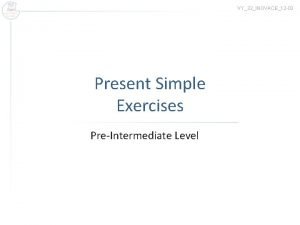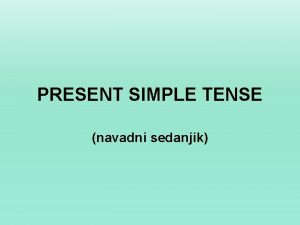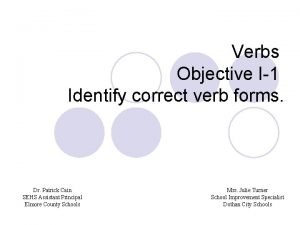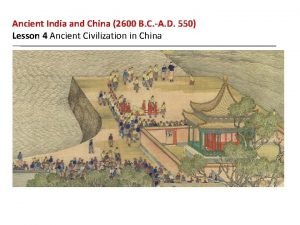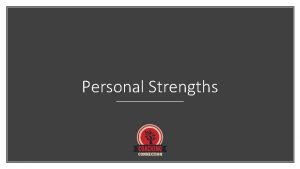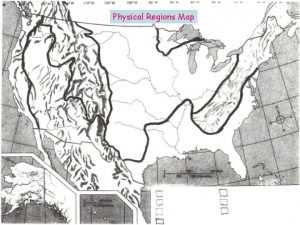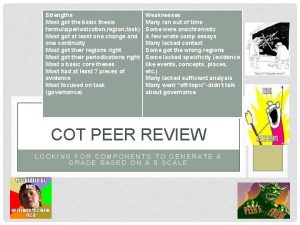Strengths Most got their regions right Most got












- Slides: 12

Strengths Most got their regions right Most got their periodizations right Most a basic core theses Most had at least 5 pieces of evidence Most focused on task (governance) Weaknesses Many ran out of time Some were anachronistic Some got the wrong regions Some lacked specificity (evidence like events, concepts, places, etc. ) Many lacked sufficient analysis Many went “off-topic”-did’nt talk about governance COT Peer Review Looking for components to generate a grade based on a 9 scale

Don’t Forget the Acronym • Thesis: the more detailed, the more points ( when, where , what) always address the question: governance • Addresses all parts of the question • Relevant world historical context used to explain changes AND continuities; AP RULE OF 3) • E evidence: must substantiate with at least 5 specific historical examples to illustrate thesis support • Analysis: explain why the changes and continuities happen ( forces, decisions, outside/inside impacts)

Forces of Change and Continuity for Social grouping/class systems continuitiy change Religion Status quo creating laws to protect elite status Societies traditional need for cheap labor Patriarchy-to protect inherited rights Birth as status/family Geography Lack of accesss to important institutions (political, educational, religious) Isolation Rural vs urban Political change ( Empires, dynasties, leaders) policy switch New religious values Trade-diffusion of new ideas, values State sponsored promotion ( education, government institutions, merit) Establishment of new laws Rebellions (peasants, revolutions, demand for change by the masses) Warfare

Expanded Core Theses • In South Asia from 600 -1600, the Code of Manu in. Hinduism reinforced the rigid hierachal nature of Caste for the purpose of social and economic harmony, women were generally child-brides betrothed through dowry and ending in Sati, however the introduction of Islam would elevate the status of women for some and reject the notion of caste and spiritual equal in the Qu’aran and Sharia • In Western Europe 600 -1600, the fall of the Roman Empire led to the decentralized policy of feudalism where people were born into their social position and constraints of contractual obligations led to a rigid social hierarchy, the role of serf and peasant were reinforced by the Roman Catholic Church’s doctrine of salvation by humility, however, the Crusades gave a new bourgeosie class an opportunity to leave the manor and engage in economic opportunities • In East Asia 600 -1600 the social status of individuals were based upon the rigid neo-Confucian ideals where individual’s responsibilities were to their families and government, women were often submissive to their husbands and sons (often with bound feet) , however, under the Yuan Dynasty (Mongol), foreigners and women had their status elevated with important court designations while the ethnically Han Chinese were relegated to second class citizens • In Latin America 600 -1600, the Spanish colonization would lead to a class based society known as las castas sytem based un racial and ethnic construction leading to a rigid social hierarchal structure, the repartamiento system would indenture the natives ( in lieu of enslavement) forcing them to labor the lands, however, slvery would persist as an avenue of agricultural and mining denying slaves and rights or respect. • In Africa from 600 -1600 societies were matrilineal and elevated the status of women based on earning potential and her bridewealth ( money to the father for economic hardship of the los of his daughter, slavery was persistent across the Sahara as captive of war would be sold in open markets in the Mediterranean and Indian Ocean for domestic work, however, the scarcity of labor in European encomiendas in Latin America would facilitate a Chattel slvery of Males dased on rthe racist notion that they were human cargo and had no right to manumission (freedom)

Change AND Continuity Over Time

Rubric • Same as DBQ for thesis (groups and time period); the global issue is the topic • Evidence – Rule of 3 – include three pieces of evidence (facts, dates, names, etc) to prove your thesis. These must be discussed and/or analyzed in order to count!!! • What happened in the world that made this happen. Include something outside of the region. • How/why was this a change? What happened? What was the process that led to change and how/why did some things STAY THE SAME?

Regions Middle East – Egypt, Israel, Iran, Iraq, Turkey Southeast Asia – Vietnam, Laos, Cambodia, Indonesia, Malaysia Sub Sahara Africa – Nigeria, Sudan, Ethiopia, Angola, Democratic Republic of the Congo, South Africa

Brainstorm South Asia West Europe East Asia Latin America Africa Hinduism Delhi Sultanate Dhimmi Caste Code of Manu Jati ( Merchant caste) Islam Sharia Trade Sati Child Brides Dowry Zakat Buddhism Mughal Tolerance Din Ali Din Foreigners Silk Road Indian Ocean Extended families Jesuit Missionaries Salvation Religious conflict Aurangzeb Akbar Feudalism Contracts Rigid social hierarchy Social contracts Crusades Commercial Revolution Roman Catholic Church “Blessed are the poor…” “A rich man getting into Heaven…” Serfdom Peasants Bourgeosie Age of Exploration Renaissance Universities Chivalry Queen Elizabeth Joan of Arc Hijo de Algo Religious intolerance Indentured servitude emmigration Religious emmigration Joint stock companies Banking Artisans patronage Sui Tang Song Yuan Ming Mandate of Heaven Confucianism vs Buddhism Neoconfucianism Foot binding Meritocracy 5 Relationships Filial piety Mongols Elevated women’s status Empress Wu Discrimination against Buddhist View of merchants Marco Polo Ibn Battuta Ming trade Zheng He Junk Ships Tribute “ A woman talking … Submissions of women Feudalism in Japan Samurai Lady Miraski Shikubu “Tale of the Genji” Code of Bushido Sinification Aztec Inca Maya Spainsish colonization Slavery Patriarchy Role of Catholic Church Encomienda Mita Repartamiento Chattel slavery Las castas system Miscegenation Law of Burgos Bartolome de Las Castas Columbus, Cortes, Pizarro Dona Maria/Malinche Indentured European migrants Peninsulares, Creoles, Mestizos, Mullatoes, Indios, Black Roman Catholic Church Audiencias Laws Brideweath Matrilineal Slavery Griots Merchants Islam Ghana, Mali, Songhai Swahili city-states Zimbabwe Benin, Ife, Kongo, Dahomey Portuguese Christianity Trans-Sahara Trans-Atlantic Domestic Slavery Chattel slavery Mansa Musa Sidiata Keita Civil wars Indian Ocean trade Indian merchants European enclaves Antonianism Family breakdown

Map it out – Outline, tables, graphics Thesis – follow same rules – groups; include time period; answer question; provide broad defining categories about what changed and what stayed the same over time; include key changing event What it was (P, S, C, E, Ed, I, T) like at the beginning? What were the key changing phenomena or events Evidence of what the conditions were like Why did the key event occur (relate to phenomena) and how did it cause change What was (P, S, C, E, Ed, I, T) like after the change? What was the same and what was different as must address continuity also Now either here or in the conclusion state how the event caused changed Conclusion and make sure that the issues of the first paragraph are the same as the issues in the last paragraph.

You are grading a rough draft not a work of art • If it exists, check it: • • • Thesis: should be addressed in the intro paragraph illustrating the where, when and what (governance). A substantial thesis with details not only puts you in the running for a possible expanded core but could earn 3 points (thesis, parts of the question) All parts of the question: governance changes and continuities (think rule of 3) Evidence: should be at least 5 and should include domestic (within region ) and foreign (outside of the region), the more you have, the higher the likelihood of expanded core. Analysis: why do things change? Why do they remain the same? This is where true knowledge of chronology comes in handy to discuss the cause/effect relationship between the decisions made by governances and other people, places and events. Expanded Core does more including details, chronlogy, casue and effects, events and trends and does no innovatively ( highly original ideas which separate you from the rest of the herd).

Common Mistakes Wrong Regions Wrong Time periods Not saying what stays the same No/little analysis – what did change and why did they NOT change • Make a global or world connection – mention something that is happening in another region or something that is worldwide • Not addressing the question (or all parts of the question) • •

 Right product right place right time right price
Right product right place right time right price Family time
Family time The right man on the right place at the right time
The right man on the right place at the right time Have got has got exercises
Have got has got exercises Past simple pravila
Past simple pravila Family and friends 2 unit 2 test
Family and friends 2 unit 2 test I got up early one morning and rushed into the day
I got up early one morning and rushed into the day Left left right right turn around go go go
Left left right right turn around go go go Put your left foot in
Put your left foot in Left left right right go go go
Left left right right go go go Aqua verb
Aqua verb The zhou kings explained their right to rule as
The zhou kings explained their right to rule as Doth with their death
Doth with their death



